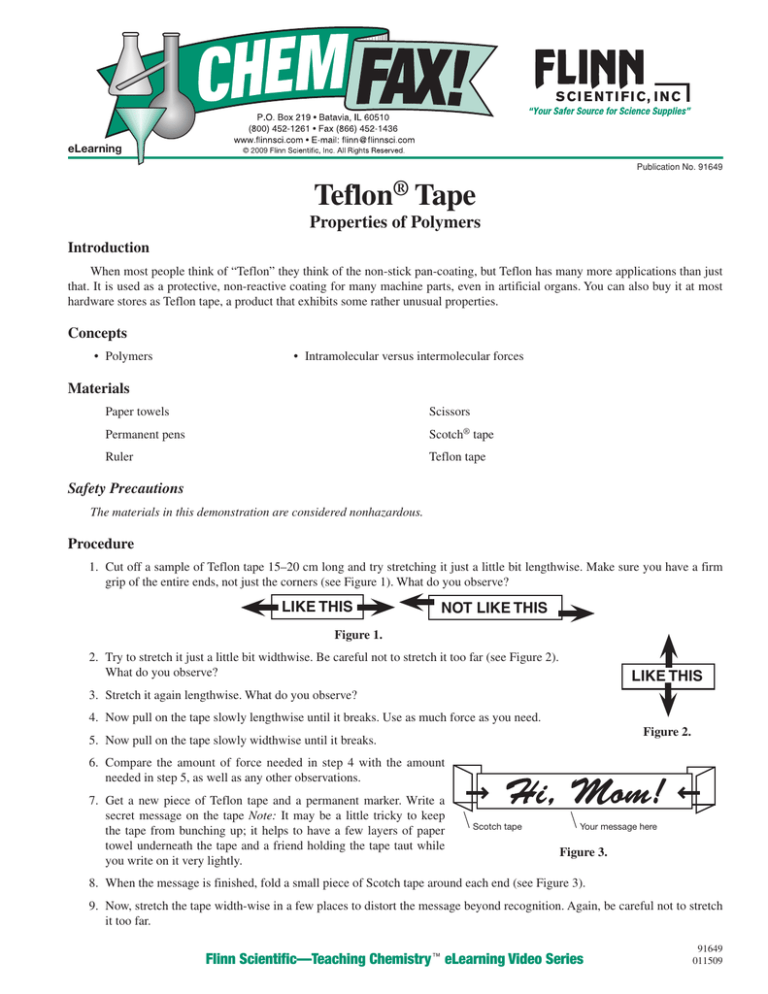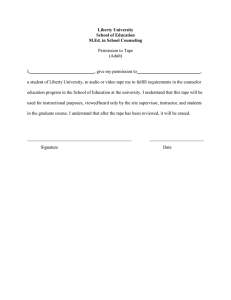
eLearning
2009
Publication No. 91649
Teflon® Tape
Properties of Polymers
Introduction
When most people think of “Teflon” they think of the non-stick pan-coating, but Teflon has many more applications than just
that. It is used as a protective, non-reactive coating for many machine parts, even in artificial organs. You can also buy it at most
hardware stores as Teflon tape, a product that exhibits some rather unusual properties.
Concepts
• Polymers
• Intramolecular versus intermolecular forces
Materials
Paper towels
Scissors
Permanent pens
Scotch® tape
Ruler
Teflon tape
Safety Precautions
The materials in this demonstration are considered nonhazardous.
Procedure
1. Cut off a sample of Teflon tape 15–20 cm long and try stretching it just a little bit lengthwise. Make sure you have a firm
grip of the entire ends, not just the corners (see Figure 1). What do you observe?
LIKE THIS
NOT LIKE THIS
Figure 1.
2. Try to stretch it just a little bit widthwise. Be careful not to stretch it too far (see Figure 2).
What do you observe?
LIKE THIS
3. Stretch it again lengthwise. What do you observe?
4. Now pull on the tape slowly lengthwise until it breaks. Use as much force as you need.
Figure 2.
5. Now pull on the tape slowly widthwise until it breaks.
6. Compare the amount of force needed in step 4 with the amount
needed in step 5, as well as any other observations.
7. Get a new piece of Teflon tape and a permanent marker. Write a
secret message on the tape Note: It may be a little tricky to keep
the tape from bunching up; it helps to have a few layers of paper
towel underneath the tape and a friend holding the tape taut while
you write on it very lightly.
Scotch tape
Your message here
Figure 3.
8. When the message is finished, fold a small piece of Scotch tape around each end (see Figure 3).
9. Now, stretch the tape width-wise in a few places to distort the message beyond recognition. Again, be careful not to stretch
it too far.
Flinn Scientific—Teaching Chemistry eLearning Video Series
91649
011509
10. Hand the distorted tape to a friend, and have the friend pull the two ends apart (see Figure 4).
Figure 4.
11. Repeat steps 9–10 several times.
Disposal
Used pieces of Teflon tape may be disposed of in the regular trash.
Tips
• For a small group, this activity would work as a gather-around demonstration. For a larger class, this is best done as an
individual hands-on activity.
• This Teflon activity can be combined with other polymer stretching activities such as stretching and relaxing rubber bands
(or uninflated balloons) against the upper lip to feel the energy exchanges that occur or by stretching out the plastic (lowdensity polyethylene) six-pack soda can holders to observe the configuration shift that occurs.
• The thickness of Teflon tape may be determined. A 100-cm length of the tape (1.27 cm in width) has a mass of only 0.33
g. Since its density is approximately the same as water’s (1 g/cm3), its thickness must be about 26 μm.
D = m/V
0.33 g
1.0 g/cm3 = ——————————
100 cm × 1.27 cm × t
t = 0.0026 cm = 26 μm
• Teflon tape is also known as “PTFE Thread Seal Tape.” Plumbers wrap it around the threads on the end of a pipe before
screwing on the next length of pipe. It acts to form a watertight seal and prevent leaking.
• Hold a small piece of polyethylene plastic wrap with a forceps in a Bunsen burner flame for a few seconds, and then take
it out. The polyethylene burns and will sustain its own flame once it is taken away from the Bunsen burner. Hold a small
piece of the Teflon tape with a forceps in a Bunsen burner flame for a few seconds, and then take it out. Teflon will char
and shrivel up, but it will not burn on its own. Thus, not only does Teflon have different physical properties than polyethylene because of the different alignment of the molecules, it also has different chemical properties, due to the different chemical composition of its polymer chains. Safety Note: Follow proper procedures for lighting and using a Bunsen
burner. Always wear chemical splash goggles whenever chemicals, glassware, or heat are used.
Discussion
The Teflon tape is very thin and soft, almost like silk. It does not stretch at all lengthwise, behaving like a taut rope.
Widthwise, however, it stretches almost indefinitely, behaving like soft putty. Most remarkably, once it is stretched widthwise into
a much distorted shape, it may be pulled back lengthwise into its precise original shape, and it resumes its rope-like nature. To
break it lengthwise takes quite a bit of force and the break is all frayed, again like a rope. Widthwise, it just keeps stretching easily,
becoming so thin it is virtually transparent, and then a tear begins and works its way through the tape, with little or no resistance.
This time the break is smooth, not frayed and runs parallel to the direction of the tape. When the tape is written upon and then
stretched out widthwise, the message becomes completely distorted and unreadable. When the tape is then stretched lengthwise,
the message becomes visible again. What’s more, the same piece may be used over and over with little or no signs of wear and
with virtually no distortion of the original message!
–2–
© 2009 Flinn Scientific, Inc. All Rights Reserved.
91649
Although we cannot see the individual polymer
strands that make up the Teflon tape, we can conjecture
about how they must be oriented so as to give rise to
these unusual properties. In regular polyethylene (plastic
wrap), the polymer strands are twisted and convoluted
and run in all different directions (See Figure 5a), giving
the material a springy stretch in all directions. In Teflon
tape, however, it would stand to reason that the polymer
strands are all relatively straight and all aligned parallel
to the length of the tape (See Figure 5b).
a. Regular polyethylene
b. Teflon tape
Fibers
Figure 5.
Imagine a bundle of 1000 beaded necklaces all running parallel and all coated with some fluid substance that makes them
stick to one another. This would serve as a fairly good model for Teflon tape, with each bead being an atom, the string being the
intramolecular covalent bonds (shared electron pairs) that hold the atoms together in the chain, and the sticky substance representing the intermolecular attractive forces acting between the polymer chains. Such an array would not stretch very well lengthwise,
for you would have to start breaking the necklaces. It would, however, stretch quite far widthwise, with the chains simply slipping over one another with little or no resistance. Stretching this array lengthwise then would clearly bring it back to its original
alignment. If stretched far enough widthwise, eventually the array would become just one strand thick, and have no choice then
but to start tearing as the strands were separated from each other. It is reasonable to argue then that since the Teflon tape stretches
widthwise quite a ways before tearing, we know it must be at least several molecules thick. In fact it is probably several thousand
molecules thick. So why can we not stretch it to several thousand times its width before it begins to tear? Hypothetically we could,
if the tape were perfectly uniform throughout and the stretching were perfectly even and smooth.
If the optional extension found in the Tips section is performed, note that the real difference between the two polymers is that
polyethylene has only hydrogen atoms branching off its carbon chain and Teflon has only fluorine atoms (see Figure 6).
H
H
C
H
C
C
H
H
H
C
H
H
H
C
C
H
C
H
H
H
C
F
F
F
C
F
F
C
polymerize into
F
F
F
F
C
C
F
C
F
C
F
F
H
F
C
F
H
H
...
C
Polyethylene.
F
C
C
C
H H
H
polymerize into
H
F
H
H
C
C
Many Ethylenes
F
H
H
C
C
H
H
H
H
C
F
F
F
C
F F
F
...
C
C
F
C
F
F
F
Many Tetrafluorethylenes
Polytetrafluoroethylene (Teflon).
Figure 6.
–3–
© 2009 Flinn Scientific, Inc. All Rights Reserved.
91649
Connecting to the National Standards
This laboratory activity relates to the following National Science Education Standards (1996):
Unifying Concepts and Processes: Grades K–12
Evidence, models, and explanation
Form and function
Content Standards: Grades 5–8
Content Standard A: Science as Inquiry
Content Standard B: Physical Science, properties and changes of properties in matter
Content Standard E: Science and Technology
Content Standards: Grades 9–12
Content Standard A: Science as Inquiry
Content Standard B: Physical Science, structure and properties of matter
Content Standard E: Science and Technology
Acknowledgment
Bob Becker’s younger daughter, Amariah Becker, deserves credit for helping co-develop this activity.
Flinn Scientific—Teaching Chemistry™ eLearning Video Series
A video of the Teflon® Tape activity, presented by Bob Becker, is available in Properties of Polymers, part of the Flinn
Scientific—Teaching Chemistry eLearning Video Series.
Materials for Teflon® Tape are available from Flinn Scientific, Inc.
Catalog No.
AP5394
Description
Scissors, Student
Consult your Flinn Scientific Catalog/Reference Manual for current prices.
–4–
© 2009 Flinn Scientific, Inc. All Rights Reserved.
91649


